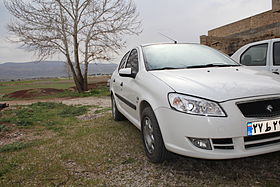IKCO Runna
| Iran Khodro Runna | |
|---|---|
 |
|
| Overview | |
| Manufacturer | Iran Khodro |
| Production | 2010-onward |
| Model years | 1391- (Iranian calendar) |
| Assembly | , Belarus (Unison) Tehran, Iran |
| Body and chassis | |
| Class | Compact car |
| Body style | 4-door Sedan |
| Layout | FF |
| Platform | Modified Peugeot 206 platform |
| Powertrain | |
| Engine | 1.6 L TU5JP4 109 PS (80 kW) L4 |
| Transmission | 5-speed MT (BE4) 4-speed AT (Optional) |
| Dimensions | |
| Length | 4,292 mm (169.0 in) |
| Width | 1,684 mm (66.3 in) |
| Height | 1,453 mm (57.2 in) |
Runna is the second of IKCO's 3rd Iranian-designed passenger car based on Peugeot 206. Code-named X12, the Runna is smaller than the IKCO Samand (X7). The Runna will be offered with at least three four-cylinder engines, including a 108-horsepower 1.6-liter gasoline unit, a 95-horsepower 1.4-liter and a 1.7-liter powerplant that runs on CNG, both of which are reported to meet Euro IV and V emission standards and the "Pedestrian Impact" safety requirement. Features are said to include airbags, antilock brakes, power steering and power windows.
The first cars were expected to reach Iranian customers in mid-2011, with exports to Turkey and other neighboring countries to begin shortly after that. IKCO plans to build 150,000 Runnas a year at full production.
A completely new appearance in the front and rear including engine hood, trunk lid, bumpers, lights, and fenders. This vehicle has a tri-chamber type structure (just like the Peugeot 206). It is made from drawn steel sheet which ranges in thickness from 0.7 mm to 2.5 mm, depending on its function. High elastic strength steel sheets are used for components that are subjected to particularly high levels of stress, such as the front structural member supports or the sub frame. This enables both greater strength and a weight reduction of around 50% to be achieved over conventional sheets which would have to be more than twice as thick to withstand the same stresses. One of the most important points at Iran Khodro Industrial Group whilst the specification for a new vehicle was being drawn up is safety. It includes active and passive safety. The first one utilizes mechanical components and vehicle dynamics to push the accident threshold as far back as possible. The second complements the first and seeks to reduce the consequences of the accident by using as many options as possible. The Runna can claim to be a vehicle which can measure up to the safety features that one has a right to expect from a modern product.
...
Wikipedia
